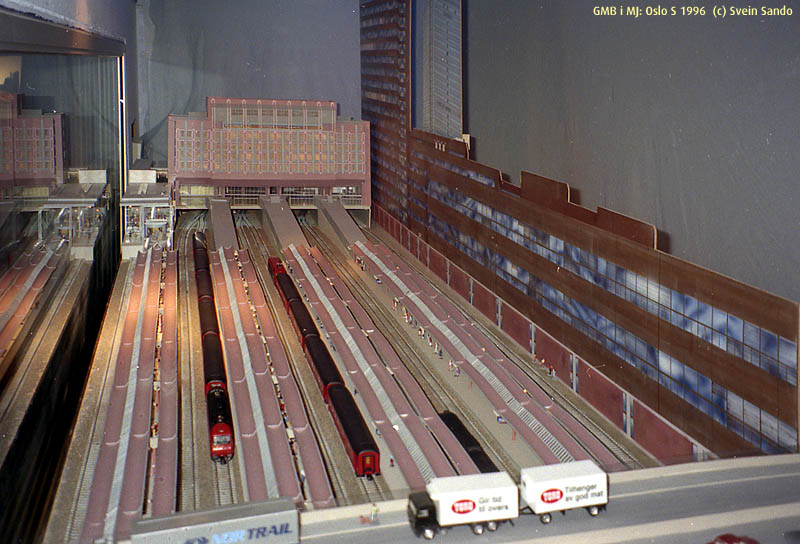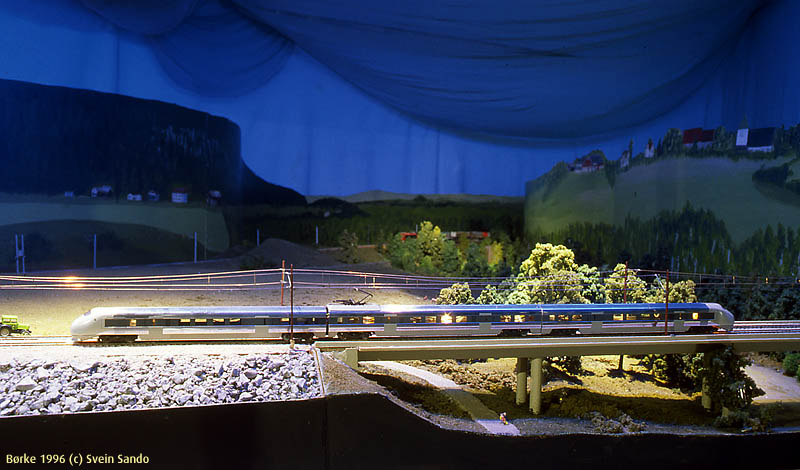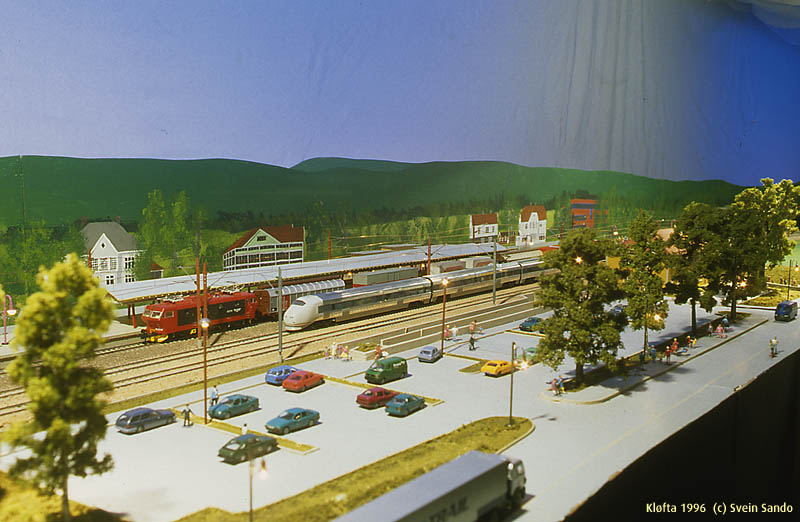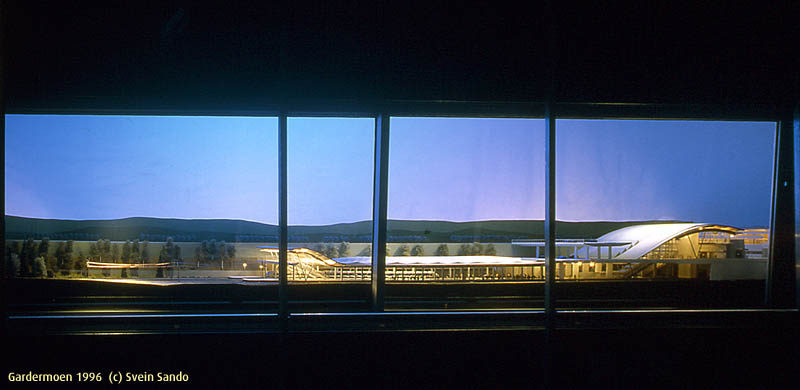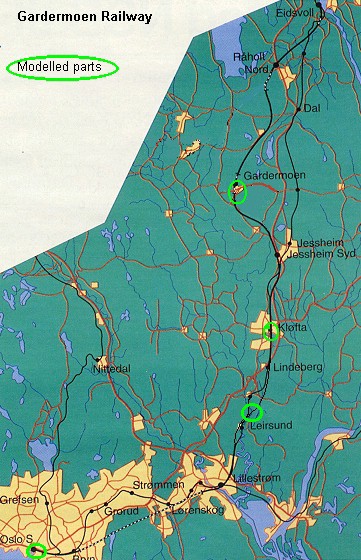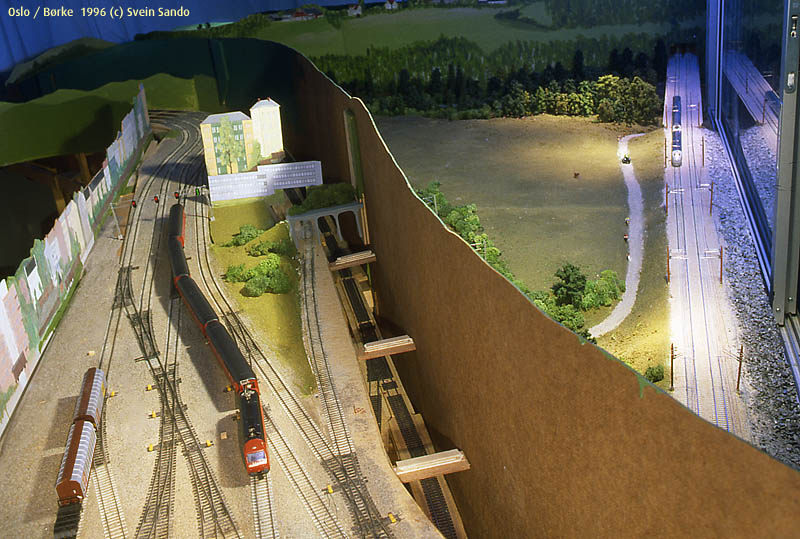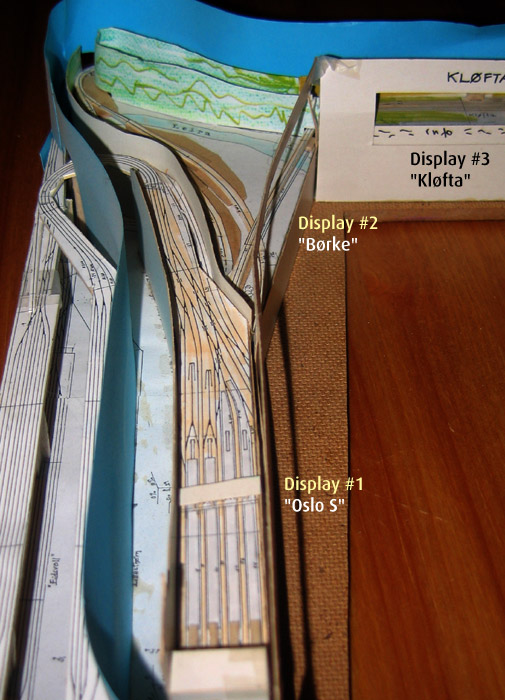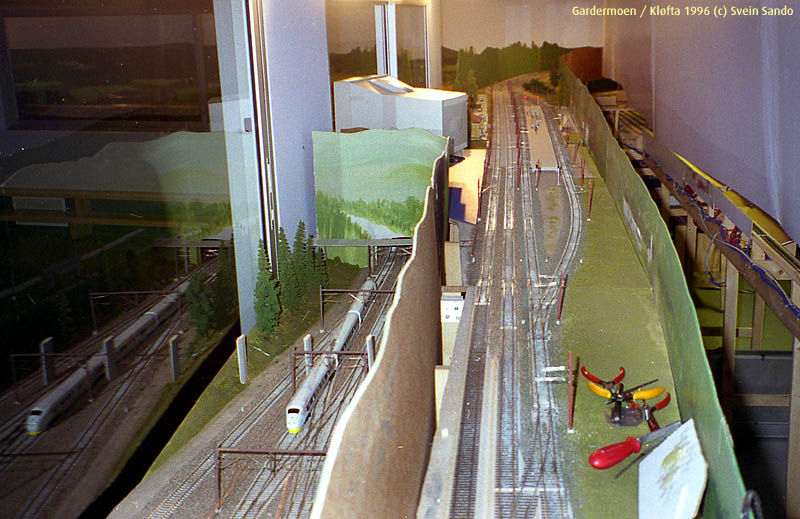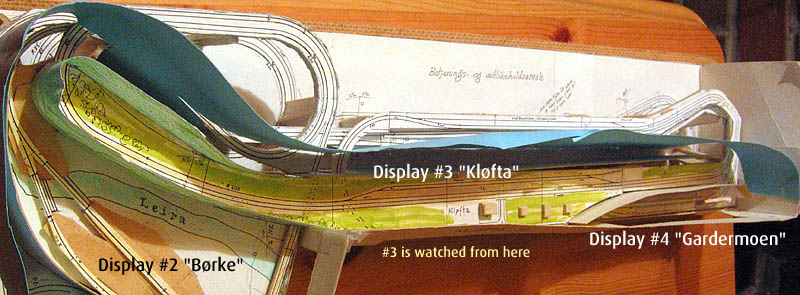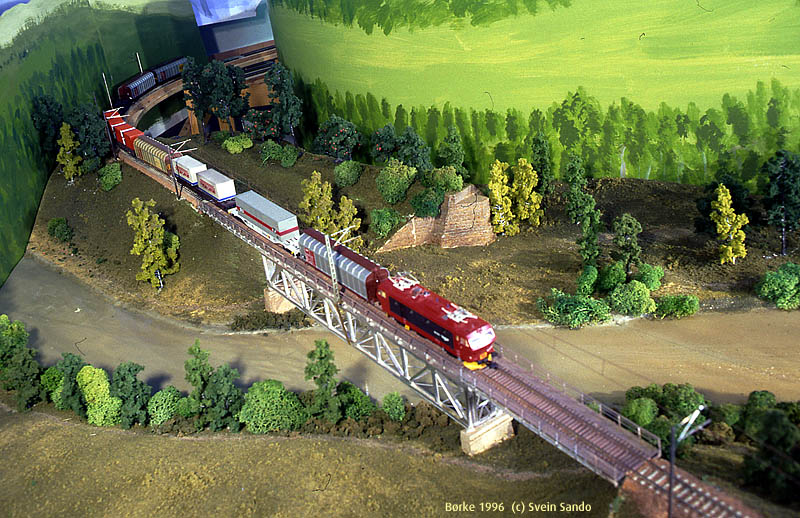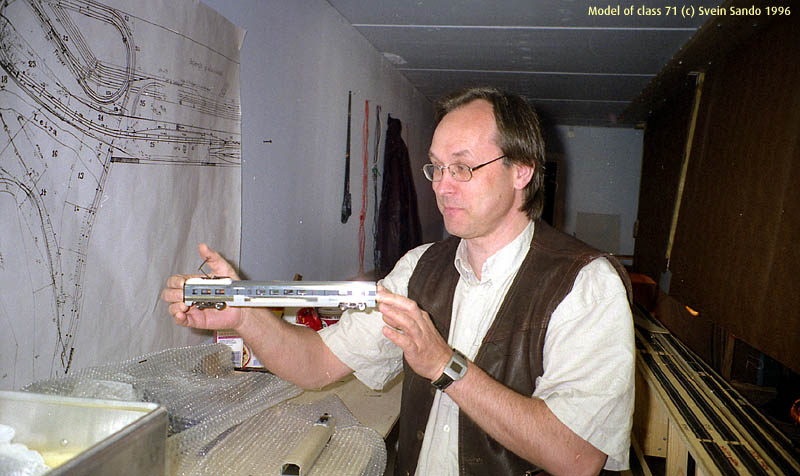|
Model railway of the new Gardermoen railway in Norway by Svein Sando A few pictures of the model railwayThe railway is modeled by means of four separate displays:
Display #1: Model of the Oslo Sentralstasjon terminal (Oslo Central Station). Only track 6-14 (of total 19) is modelled, but the platforms modelled are in true 1:87 scale length. On this scene, everything except track and automobile cars are scratchbuilt. Øystein Wiik painted the backdrop.
Display #2 contained a scenery from the Leirsund - Kløfta area. The river Leira is crossed by a concrete bridge. The train is a high speed train bound for the airport.
Display #3: Model of the suburb station Kløfta. Only the interurbans are calling here. The high speed airport trains (in front), the Inter-City trains and freight trains (at the plattform) are just passing. The freight train is hauled by the at the once NSB class El 16, which is similar to the Swedish class Rc. The airport train is the new NSB EMU class 71, based to some extent on the Swedish X2000.
Display #4 is the railway station at Gardermoen International Airport. This view also shows how the visitors viewed the model railway. The darkness outside and the bluish back light and spot lights at some interesting points at the railway was added in spring 1996 by an P.R. agency. A series of pictures was also taken the last day this model was in operation. A model of a prototype railway under constructionThe 8th of October, 1992, the Norwegian Parliament ("Stortinget") decided to build a new international airport for the capital Oslo at Gardermoen. The distance from Oslo to Gardermoen is 48 km and the Parliament decided that the main transportation device between the airport and the capital should be a high speed railway.
Map of the Gardermoen Railway The Norwegian State Railways (NSB) decided to form a daughter company to build, and later also to operate, the new high speed railway. The new railway was formed the 24th of November 1992 and given the name "NSB Gardermobanen AS" (NSB Gardermoen Railway Ltd.) or GMB for short. Even before GMB was officially formed, the internal news magazine in NSB, Vårt Yrke, had an article about the high speed line to Gardermoen. In this article the reader was told that NSB/GMB wanted to make "a miniature model of the Gardermoen railway, which could show both construction and operation of the Gardermoen railway." I found this notice interesting. Since I knew the person who had written the article, I asked if they needed some assistance with this model and asked if anyone was given the job to build it. This was the beginning for a more than three years long construction project for me, that was completed in some fashion in June 1996. I was given the main responsibility to design and build a model railway of parts the Gardermoen line. Up to that time, I had mainly built models of railways of yesterday. The last two/three were model railways with specific prototype railways, namely Kristiania-Drammen Railway (from the 1920-ies) and Trondhjem-Støren-Røros Railway (1940-55). It was therefore a new experience for me to design and build a model of an ultra modern railway. The concept of extended windowsIt was impossible to model the whole 48 km long railway, so we decided to pick four spots along the line which would be showed through four dispalys behind protecting windows. We chose the two terminals Oslo S (#1) and Gardermoen (#4), Kløfta station (#3) and the crossing of the river Leira by Børke (#2) between Leirsund and Lindeberg stations on the present line. On the model the four spots were visually separated from each other by making each spot a window just like a store front or shop display. This takes care of the separation of space between the four modelled parts of the railway. The map above of the GMB will show the situation of the four windows. The problem with using windows in model railways, is twofold: On freelance model railways the tracks can leave the window/display on a natural manner by using tunnels or disappearing behind trees or tall buildings. On a model which ought to be true to the prototype, this is often an impossible solution. You can't invent a tunnel or a factory just for the sake of the model. The tree or forest-solution is more plausible, but not so effective as the tunnel-way-of-getting-rid-of-the-trains. With my concept "extended windows through flanks" these problems are at least reduced, and it gave one additional advantage: significant enlargements of half of the windows. By letting every second window be placed so low that the tracks can pass under the adjacent windows, the higher levelled windows can be extended to the flanks behind the backdrop of the lower levelled windows. This photo shows the concept. Display #1 (left) is extended behind display #2 (rigth):
The nearly same view at the model of the model shows even better the concept of extended windows:
The below photo of Kløfta and Gardermoen stations and the photo of the model og the model, shows the principle. By placing the tracks close to the window and letting them extend outside the window opening, it is hard to see how they disappear. With long flanks, like on Kløfta window, the tracks disappears behind trees and a curved backdrop. The visual part of of this window is about 12m even if the window itself is "only" 5m long.
In addition to show the concept of extending windows, it shows how the blue sky is hanging down from the ceiling ca 0,5 meter from the upstanding backdrop, giving room for maintenance area.
The deep Børke window (display #2) makes the old railway disappear behind prototype situated trees 3,5 m away from the observers, in this photo however viewed from a maintenance viewpoint at the bottom of the display:
The main problem with this arrangement, is that some tracks are situated under some other parts of the layout and are thus harder to reach for maintenance and train rescue. This can be reduced by restricting oneself (which I regrettably did not) from putting turnouts in such hardly reachable places. Controlling the trainsSince this model railways is built for the public, and not for the fun of operation for model railway enthusiasts, we decided to operate the railway by a computer and make it completely automatic. I had experience with Bruce Chubb's Computer Memory Railroad Interface (CMRI) as described in a series of articles in Model Railroader magazine, I decided to use the same versatile system on this model railway. It operate things on the model through output cards which acts like ground switches (open collector circuits). The PC checks the model the similar way by input cards, by checking if things are grounded or not. With the output cards the PC can control turnouts, signals, relays, LED's and cabs (train speed). The Optional Detector cards checks if a locomotive or any other current consuming rolling stock is on a particular track. By reading this detectors, the PC gets information about train positions. The railway is operated by a software program in Turbo Pascal (DOS platform) which I wrote especially for this model. Through a modem I can run the trains from my home. This is very important in order to maintain full operation every day. It is thus very easy for me to de remote assistance of the operation in case of failure. High speed trainsThe initial plans to show the new high speed airport trains, was to repaint and do some minor alteration on a continental high speed train, e.g. the German ICE. The differences between the available models of high speed trains and the NSB class 71, was so large, that we decided to scratch build the models in order to get a true scale model. I made the first model in Sept 1995 after the then assumed plans for the train. This was a test model made of white styrene sheet (the prototype was then supposed to be painted white). The running gears etc. was taken from a Roco #43655 model of SBB "Bahn 2000". These trucks had the right distance between the axles, but the diameter of the wheels was too large. The speed and running performance is however very good.
We were in need of four high speed trains. The test model was found too fragile and since the "colour" of the trains seemed to be stainless steel, it was decided to build four new models of the trains. Skøyen Modellverksted by Jan Reinsborg (picture above when delivering the trains 16.6.96) was asked to produce these four models, since he had already made non-running models in larger scales for NSB Gardermoen Ry.. He was also involved in a 1:1 model of the aerodynamic front of the prototype. In June 96 he delivered the four required models of what at that time seemed to be the appearance of the class 71. This strong connection between the construction of a model railway train and 1:1 production of the same train is quite interesting. Is it unique? The stainless steel car bodies was modelled by making the cars of polished extruded aluminium. The aluminium profile was made so that all other main parts of the model could be slided inside from the ends. Bogies, motor, pantographs, couplers etc. was taken from Roco #43006, a DB class 420 3 cars EMU which has bogies of very similar appearance as the NSB class 71. It was however one problem with them since the DB class 420 is not intended to run in 200 kph. We have a little problem in getting the trains running fast enough without making too much noise due to increased voltage. The distance between the bogies on the NSB class 71 is also much larger than on the central car at the DB class 420. We therefore had to make the shafts from the motor to the bogies much longer than Roco had made them. This is also a source for noise and possible future trouble. We may have to rebuild this gearing. A test unit is running with original distance between motor and bogie, but with only one (of original two) bogies driving. This works good on fairly flat line, but it won't climb steeper gradients. Experiences by Feb. 1997: The above mentioned Roco-gears for the high speed trains are regrettably of lower quality. The gearhousing is made of plastic, and worms tends to get out of positions, Things are getting worn out too quickly. We have therefore decided to replace the Roco-gearing and motors with 2 Fleischmann motor trucks in each driving unit from Fleischmann DMU 4438. Two sets are rebuilt and we are testing them these days. Closure of the model railway exhibition - news notes in 199810 Oct 1998: This model railway will cease operation at the Information Centre for the new Oslo Airport, Gardermoen in middle of December this year, due to the closing of the Information Centre. The new airport was opened 8th Oct, and the purpose of the Information Centre is thus minimised. The Gardermoen Railway Club (GMJK) will "inherit" the model railway. GMJK hope to find a new location for the model railway so it can be put into operation again. To achieve this, the railway must probably be rebuilt due to its present demanding shape: L-formed with each leg about 14 meters long. 12 Dec 1998: The last trains were started at 10:12 AM. Pictures of the railway this last day are presented on a separate page. The disassembly of the model started the same evening. The future location of the model is not decided, but the hope is that reconstruction in a new spot in the region will start within half a year. Facts
This article is shown 319075 times |
|||||||||||||||||||||||||||||||||||||
| Ett tilfeldig blant 30 MJ-bilder fra anlegg jeg sammen med andre eller alene har vært med på å bygge: | ||||||||||||||||||||||||||||||||||||||
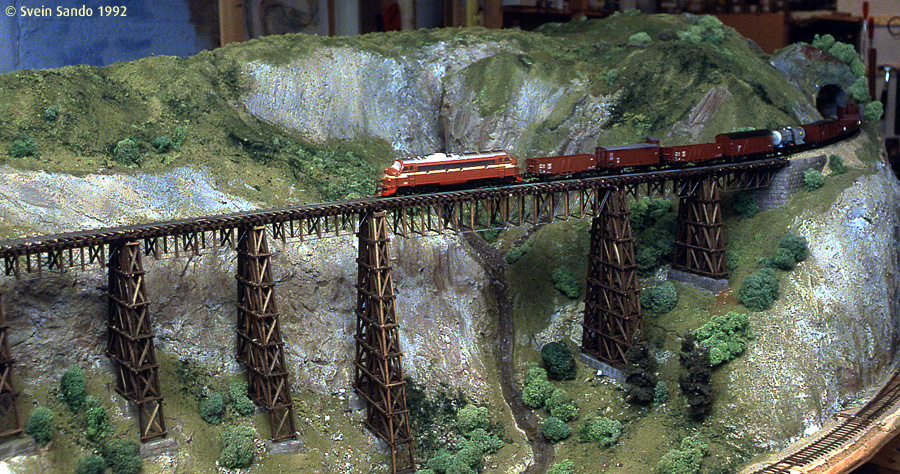 | ||||||||||||||||||||||||||||||||||||||
I dag 748 treff på mj, og 3322785 totalt siden 28.11.2007 21:52. Dagsgjennomsnitt: 546 treff ·
|
© Svein Sando - e-mail: ssando |
| Start page (Eng.) · Startside (Norw.) · · Display modes: Standard · Without menus: Arial · Times · Times spacious · Large · |
The content of this webpage is subject to Norwegian legislation about copyright, which gives the author all publications wrights. Any further publication of this text and its pictures, completely or partly, can only be done after being authorized to do so by the author. Shorter citation in papers, students essays and so forth can be done if referring to the source. APA style reference to this webpage:
Sando, S. (1996/2005). Model railway of the new Gardermoen railway in Norway. Downloaded 27.07.2024 from https://www.sando.co/index.php?vis=234&nid=3&eng=1
Php-versjon 7.4.33

